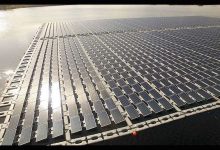Regional officials in eastern German Cottbus have given the green light for the country’s largest floating solar power plant to be built on the man-made Cottbus Ostsee lake, a former open-pit lignite mine, announced the city’s mayor Holger Kelch (CDU) alongside energy company LEAG.
With the political go-ahead, the project developers LEAG and EP New Energies (EPNE) can apply for the necessary building permits by the end of the year, said a press release.
Construction works for the plant, which will generate around 20,000 megawatt hours (MWh) of electricity per year, could start as early as spring 2023. Leag had said earlier this year that the plant could also begin operation next year.
“Although the floating solar plant on the 1,900-hectare Cottbus Ostsee lake is to occupy less than one percent of the lake’s surface, the plant will make an important contribution to the climate-friendly power supply of Cottbus’ harbour district,” head of renewable energies at LEAG Fabian von Oesen said.
The size of the lake makes it possible to install such a floating solar power plant without encroaching on lakeshores used for tourism or disturbing planned shipping routes, said the press release. LEAG calculates the plant will produce enough electricity to supply 5,700 households annually.
“Floating photovoltaics is only the first step that we are taking together; other projects, such as wind turbines and a lake water heat pump, will follow,” Kelch said. The Cottbus Ostsee, an artificial lake under development on the grounds of a former open-pit lignite mine in eastern Germany, is set to become Germany’s largest artificial inland lake this decade. LEAG is also planning other renewable projects in the state of Brandenburg on other former fossil fuel sites.
This article was originally published on Clean Energy Wire. Reproduced with permission.










